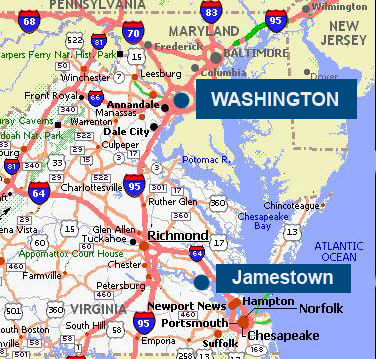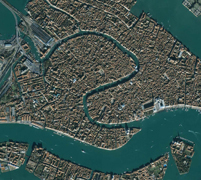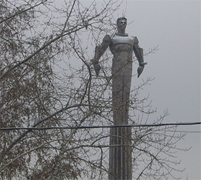
MOON BASE
EPISODE II
Jamestown on the Moon
Cyrano first attempts to travel to the
Moon by strapping bottles of lighter-than-air dew to his body, but
after reaching the Middle Distance, he floats back to Earth, landing
among a tribe of naked Indians in New France. There he builds a machine
that eventually takes him to his destination, which no doubt goes to
show that America has always been the ideal place for moon launchings.
(Paul Auster)
(Paul Auster)
There
is plenty of reference to exploration in Washington DC. The District of
Columbia pays an obvious tribute to the discoverer of the new world.
Jamestown, the first English settlement in North America, is only a
couple of hundred miles south, at the very end of the Chesapeake Bay.
Downtown Washington, across The Mall, the Space and Air Museum displays
the most impressive collection of flying machines ever built: from
wooden planes with fragile canvas wings to the Spaceship One - whom
just succeeded in performing two sub-orbital flights in a row, thus
paving the way for space tourism. All sort of rockets and spacecrafts
used in fifty years of automatic and manned space missions are also
either hanging from the ceiling or raising high above the floor. At the
entrance, an Apollo capsule with burnt shield and a lunar rock sample
welcome visitors from all over the world.
Here, close to the barycentre of the United States, an evening event celebrated the successful organization of the second Moon Base Conference. The NASA Administrator’s speech was followed by the IMAX projection “Magnificent Desolation”, displaying through spectacular views of the lunar surface and of the moonwlkers the major achievement of the Apollo program.
During the Washington workshop contributions focused on the way in which a lunar permanent outpost could be realized: space transportation, transfer trajectories, life support systems, health hazard, in-situ resources utilization, scientific experiments and infrastructures. Last but not least the financial and economic framework needed to sustain a long-term manned lunar exploration program. In short, Jamestown-on-the-Moon, as the lunar base was provisionally christened, started to take shape under realistic assumptions.
Radiation hazard during the flight to the Moon (mostly outside the sheltering action of the Van Allen Belts) and on the lunar surface is a major concern. Unpredictable solar flares represent a threat difficult to handle: the ’72 event, occurring between the Apollo 10 and 11 missions, could have had catastrophic consequences. Although quick transfers (3-4 days) still represent the safest way for humans, novel orbital paths connecting the Earth and the Moon are now available. The stable/unstable manifolds approach and the so-called weak stability boundary (WSB) trajectories exploiting the chaotic regions associated with the collinear lagrangian points, provide long-duration fuel-sparing alternatives to be used for maximising the payload mass on board automatic cargo servicing missions.
On the lunar surface, peculiar geologic features (e.g. lava tubes, small craters) could ease the effort of building up radiation resistant thick walls and ceilings. Surface manned activities could greatly profit of astronaut “armours” and of cooperative robotics for performing the many different tasks involved in ruling a fully operational lunar base.
 Among
the enabling technologies, harnessing the Moon’s resources is mandatory
for lowering the dependence from Earth. Self replicating automata, made
out of the same material they contribute to manufacture provide the
ideal answer. The construction of power plants for energy production,
either solar or based on He3 nuclear fusion, and factories for
extracting oxygen and other elements from the lunar regolith represent
a more traditional, yet still valid approach.
Among
the enabling technologies, harnessing the Moon’s resources is mandatory
for lowering the dependence from Earth. Self replicating automata, made
out of the same material they contribute to manufacture provide the
ideal answer. The construction of power plants for energy production,
either solar or based on He3 nuclear fusion, and factories for
extracting oxygen and other elements from the lunar regolith represent
a more traditional, yet still valid approach.
The celebrated experiment of “the hammer and the feather” performed live by the Apollo 15 commander David R. Scott back in 1972, is a striking example of the benefits of doing science on the Moon. In this respect scientific applications can be divided into three broad categories: science of the Moon, science on the Moon and science from the Moon. The latter foresees the construction of a condominium of astronomical observatories: the absence of atmospheric disturbances or diffusion and the low lunar gravity will presumably allow optics technology to face unprecedented challenges. The electromagnetically noiseless environment of the far side of the Moon is the dream come true for radio astronomy. Both projects link up well with the studies carried out for providing global telecommunication networks and advanced remote control techniques (telepresence).
Cultural contributions have been also acknowledged. The Alexandra Archive deals with the possibility of safely storing on the Moon the whole body of knowledge achieved by mankind, thus preserving it against “Earthly” destruction. The implementation of a Moon Base knowledge and imagination portal could undoubtedly foster lunar exploration.
Coming down to more practical issues, it is clear that the present feasibility and the future development of Jamestown-on-the-Moon depends upon the level of resources allocated by the international community. Roadmaps and budgetary exercises have been therefore discussed. The completion of large on-going space programs such as the Space Shuttle and the International Space Station will presumably free a significant fraction of NASA and ESA budgets, thus making exploration programs more affordable. Moreover government and private interests can participate at each step in the lunar activity value chain, opening a somewhat different scenario also from the stakeholder’s viewpoint.
As far as programmatic aspects are concerned, the optimistic view still prevails: if the first child born on the Moon will be an historical event, then the mother is already alive on planet Earth
Here, close to the barycentre of the United States, an evening event celebrated the successful organization of the second Moon Base Conference. The NASA Administrator’s speech was followed by the IMAX projection “Magnificent Desolation”, displaying through spectacular views of the lunar surface and of the moonwlkers the major achievement of the Apollo program.
During the Washington workshop contributions focused on the way in which a lunar permanent outpost could be realized: space transportation, transfer trajectories, life support systems, health hazard, in-situ resources utilization, scientific experiments and infrastructures. Last but not least the financial and economic framework needed to sustain a long-term manned lunar exploration program. In short, Jamestown-on-the-Moon, as the lunar base was provisionally christened, started to take shape under realistic assumptions.
Radiation hazard during the flight to the Moon (mostly outside the sheltering action of the Van Allen Belts) and on the lunar surface is a major concern. Unpredictable solar flares represent a threat difficult to handle: the ’72 event, occurring between the Apollo 10 and 11 missions, could have had catastrophic consequences. Although quick transfers (3-4 days) still represent the safest way for humans, novel orbital paths connecting the Earth and the Moon are now available. The stable/unstable manifolds approach and the so-called weak stability boundary (WSB) trajectories exploiting the chaotic regions associated with the collinear lagrangian points, provide long-duration fuel-sparing alternatives to be used for maximising the payload mass on board automatic cargo servicing missions.
On the lunar surface, peculiar geologic features (e.g. lava tubes, small craters) could ease the effort of building up radiation resistant thick walls and ceilings. Surface manned activities could greatly profit of astronaut “armours” and of cooperative robotics for performing the many different tasks involved in ruling a fully operational lunar base.
 Among
the enabling technologies, harnessing the Moon’s resources is mandatory
for lowering the dependence from Earth. Self replicating automata, made
out of the same material they contribute to manufacture provide the
ideal answer. The construction of power plants for energy production,
either solar or based on He3 nuclear fusion, and factories for
extracting oxygen and other elements from the lunar regolith represent
a more traditional, yet still valid approach.
Among
the enabling technologies, harnessing the Moon’s resources is mandatory
for lowering the dependence from Earth. Self replicating automata, made
out of the same material they contribute to manufacture provide the
ideal answer. The construction of power plants for energy production,
either solar or based on He3 nuclear fusion, and factories for
extracting oxygen and other elements from the lunar regolith represent
a more traditional, yet still valid approach.The celebrated experiment of “the hammer and the feather” performed live by the Apollo 15 commander David R. Scott back in 1972, is a striking example of the benefits of doing science on the Moon. In this respect scientific applications can be divided into three broad categories: science of the Moon, science on the Moon and science from the Moon. The latter foresees the construction of a condominium of astronomical observatories: the absence of atmospheric disturbances or diffusion and the low lunar gravity will presumably allow optics technology to face unprecedented challenges. The electromagnetically noiseless environment of the far side of the Moon is the dream come true for radio astronomy. Both projects link up well with the studies carried out for providing global telecommunication networks and advanced remote control techniques (telepresence).
Cultural contributions have been also acknowledged. The Alexandra Archive deals with the possibility of safely storing on the Moon the whole body of knowledge achieved by mankind, thus preserving it against “Earthly” destruction. The implementation of a Moon Base knowledge and imagination portal could undoubtedly foster lunar exploration.
Coming down to more practical issues, it is clear that the present feasibility and the future development of Jamestown-on-the-Moon depends upon the level of resources allocated by the international community. Roadmaps and budgetary exercises have been therefore discussed. The completion of large on-going space programs such as the Space Shuttle and the International Space Station will presumably free a significant fraction of NASA and ESA budgets, thus making exploration programs more affordable. Moreover government and private interests can participate at each step in the lunar activity value chain, opening a somewhat different scenario also from the stakeholder’s viewpoint.
As far as programmatic aspects are concerned, the optimistic view still prevails: if the first child born on the Moon will be an historical event, then the mother is already alive on planet Earth
ettore perozzi


